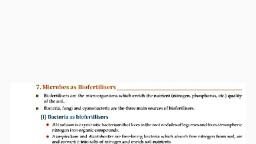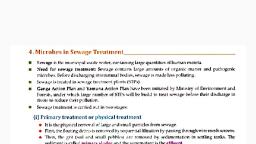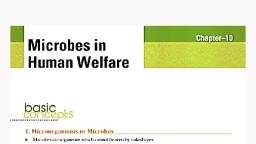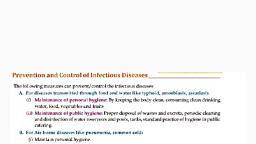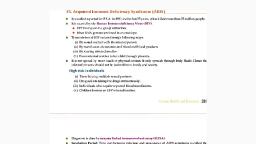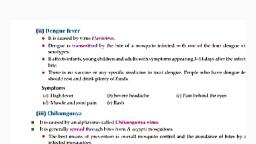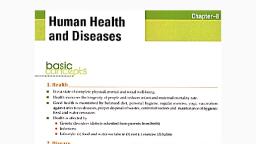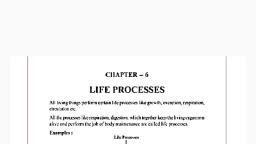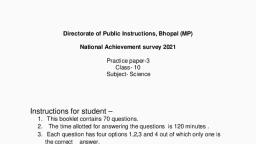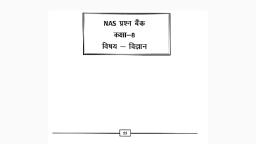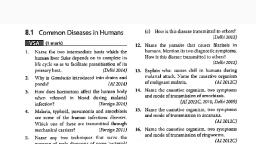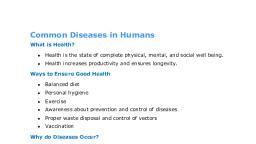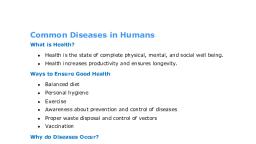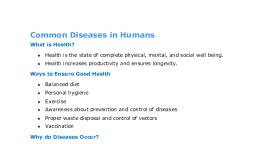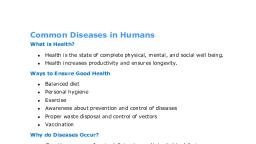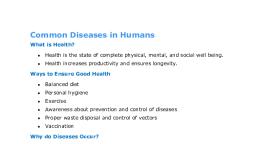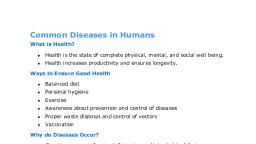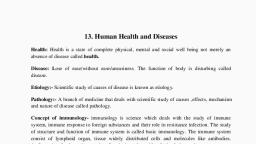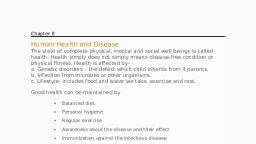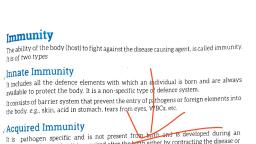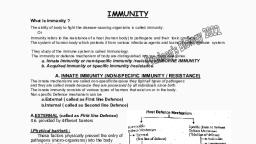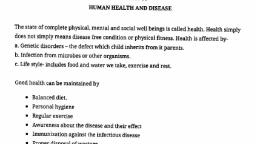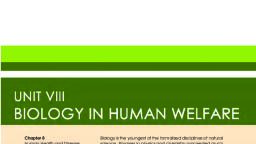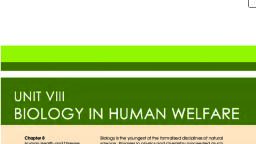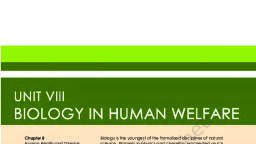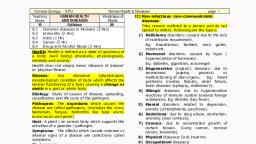Page 1 :
Prevention, , and Control, , of Intectious, , Diseases, , The following measures can prevent/control the infectious diseaes:, A. For diseases transmitted through food and water like typhoid, amoebiasis, ascariasis., ( Maintenance of penonal hygiene: By kevping the body ckean, consuming clean drinking, w.ater, lwxl, vegetables and truits., in Maintenance of public hygiene: Proper disposl of wastes and excreta. periodic cleaning, and divinfertion of water reservoirs, and povls, tanks, standard practice of hygiene in public, , Catering, B. For Air-borne, , diseases like pneumenia, common cold:, , () Maintain permnal hygiene., , Maintain public hygiene, (in) Close ceontact with infected persons or their belongings should be avoided., C.Fur vectur-horne diseases like malaria, filariasis dengue chikunguniya to above measures,, close contact with infected persons or their belongings should be avoided., (0) Eradicatim of vectors and their breeding places., (") Use vt monquito net, (ti) Aveid stagnation of water, (), , Human Health and Diseases, , 297, , (io) Introduce fishes like Cambusia in ponds that fevd on mosquito Larvas, , ditches drainage areas, swamps., (ri) Wire mesh at doors and windows to prevent entry of mosquitoes., D. Vaccination and immunisation programmes ftor diseases like polio, diphtheria, tetanus, etc., E. Use of antibiotics and drugs to treat the intexted person., (r) Spray insecticides, , in
Page 2 :
9.Immunity_, the ability of an organism to resist or detend itselt from the development ot a disease., , Itis, , Immunity, , nnate immunity, , Acquired immunity, , (Inborn immunity), , (Adaptive, , Active immunity, , mmunity), , Passive immunity, , (i) Innate immunity, It, , present from the birth and is inherited from parents., , is, , It is non-sperific type of defence., It is accomplished by providing different types of barriers to entry of foreign agents 4 types of, , are, , barriers, , (a), , Physical barriers, These barriers do not allow pathogens and foreign agents to enter the body, eg skin, mucous, membranes of digestive, respiratory and urinogenital tracts trapping microorganisms., , (b) Physiological barriers, Sweat, tears from eyes, acid in the stomach and saliva in mouth prevent micnobial growth., (c), , Cellular barriers, WBCs (polymorphonuclear leukocytes PMNL-neutrophils), and monocytes (natural killer, lymphoeytes) and macrophages phagocytose and destroy microbes., , (d) Cytokine, , barriers, , Proteins called interferons produced by virus-inkected cells protect non-infected cells from further, viral inkection., , (ii) Acquired immunity, It is not preent from the birth and develops during an individual's lifetime., It, It, , pathogen specific., has the ability to distinguish diverse types of foreign molecules or antigens (specificity)., When the immune system encounters a pathogen for the hrst time, a primary respone s, produced which is of low intensity. The memory of this encounter with the same pathogern is aso, formed. On subsequent encounter with the same pathOgen, à secondary or anamnestic response, is produced which is of very high intensity because of memory of first encounter., Immune respomes are produced by two types of lymphocytes, is, , 298 Xam idea Bulony-, , XII, , (a) B-lymphocytes or B-cells proxluce an army of proteins called antibodies in blod, in response, to pathogens., (b) T-lymphocytes or T-cells help B-cells to produce antibodies., , Two types eof acquired mmune respones or immunities develop in the body:, (a) Ilumoral immune response or antibady mediated immunity (AM): It is mediated by, antibodies in the blood and lymph (humor)., b) Cell-mediated immune response or cell-mediated immunity (CMI: It is mediated by, Tlymphoeytes. It is responsible tor gratt rejection in organ transplant because of its ability, to diferentiate betwen 'self and 'non-self, Tissue matching, blood group matching are, thus essential betare any gratt/transplant and even atter this, patients are given immune, suppressant all their lives,, Table 8.3: Differences between active and passive immunity, , S. No., , Immunity, Fassive immunity, tu contact with pathogent is developd when eadymade antibodies are, antigen, that leads to incted into the body to protect boxdy against, (dead or, agents., proutheh ot antibeds in the hoNt bNIy,, may cau a reaction., has na or only few side vttects._, ACHVe, , ts, , deveupe, , de, living) or, , s, , regn, , t, , ()t, (), , tS, , slow but long Lasting, t takes time to develop its respon, , 0, (), , For example, vaccination, , for polo, etc., , Itis tast but lasts only or tew days., t, , is, , used when the immune, , respone, , has to be, , For example, administration ot tetanus, , antitoiS, Antitxlies in colostrum, etc., (v)Injecting microbesdeliberately during Foetus receives some antbolus from their, or teetons ogAnsis enteing, unst, htne toug Pcenta auing preEnaney. |, bdy, , ineduce active immunity., , Iwhich mduce, , passIVe Immurnity.
Page 3 :
3., , Given, , below, , is the, , structure of an antibody., , Antigen binding ste, , Andgen bhdhg, , ught, , Llght, , ste, , chah, , Chan, , Dsuflde bonds, edvy, , chans-, , C, years, (n Aboy of ten, chicken po. Ile is not expected to have the same discave for there, of his 1ife. Mentionhad, how it is possi, why is secondary immune response more intense than the primary immune response i, , ii, , (iinh, , 314, , Ans., , humans?, , Some allergens trigger sneezing and wheezing in human beings. What causes this type, Tesponse by the body?, , Xamidea E:ology-XII, , () The boy when encounters a pathogen for the first time, his body produces antibodies th, esuits, in the memoryot the ist, encounter, to protect the body in future, (i) This is because of presence of antibodies developed during primary., (an)The exaggerated response ot the immune systems to certain antigens (allergens) present i
Page 4 :
10. Antibodies, are protein molecules called, Antibodies, immunoglobulins (lg) and are of 4 types, , Antlgen blndlng, , Antigen binding site, , site, , gA, IgM, lgE and lgG., , antibody has a Y-shaped structure., molecule consists of four, "Each antibody, polypeptide chains, two are long called heavy, ( chains while the other wo are short, called light (L) chains. Hence, an antibody is, represented as lla, gG is the most prevalent antibody in the, blood followed by IgA and IgM., is present in breast milk (colostrum)., lgA, An, , gnt chaln, , Disutkde bonds, Heavy, , cnans, , -<, , Fig8.3 Struchure of an antibody molecule, , 11. Vaccination and, , lmmunisation, , Vaccination is the process of introduction of weakened or inactivated pathogens or proteins (vaccine), , into a person to provide protection against a disease., Vaccines are weakened or inactivated pathogerns or proteins introduced into a person to provide, protection against a disease,, , Human Health and Diseases, , 299, , is the process by which the body produces antibodies against the vaccine (primary, "Immunisation, response) and develops the ability to neutralise pathogens duringactual infertion (secondary response)., Vaccination provides immunisation atter a time gap., Vaccination and immunisation are based on the property called "Memory' of the immune system., vaccine generates memory B- and T-ells that recognise the pathogen on subsequent exposure, The, response, and produce an intense immune, Ifa quick immune response is needed, as in tetanus infection or snake bite, preformed antibodies or, antitoxin is injected into the patient. This type of immunisation is called passive immunisation., mBy recombinant DNA technology, vaccines have been produced on large scale, rg. hepatitis-B, vaccine is produced from yeast., , 12. Allergy, exaggerated or hypersensitive reaction of the immune system to certain antigens present in the, is called allergy., The, substances/agents which produce an immune response in an individual are called allergens,, 8pollen grains, animal dander, dust, feathers, drugs like penicillin, etc., lgE antibodies are produced in response to allergens, , The, , environment, , Chemicals like histamine and serotonin released from the mast cells., , Cause:, , Sneezing (ü) Watery eyes (i) Running nose (ir) Difficulty in breathing, lke anti-histamine,, adrenalin and stera1ds quickly' reduce the symptoms ot allergy, "Drugs, To, determine cause of allergy, patient is injected with very small doses of suspected allergens and the, , Symptoms:, , (i), , reactions are studied., , day lifestyle has lowered immunity and increased sensitivity to allergens., , Moderm, , 13. Auto Immunity_, is an abnormal immune response in which the immune systerm of the body starts rejecting its own, body cells or 'self cells and molecules, hence bady attacks self cells thus damaging the body., exanmple, rheumatoid arthritis, Addison's disease., For, , It, , 14. Immune System, Components, , of immune system, , Lymphoid, , organs, , Immune cells, Soluble molecules like antibodies




